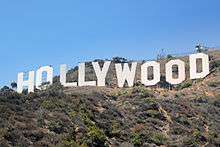Hollywood Bowl
The Hollywood Bowl is an amphitheatre in the Hollywood Hills neighborhood of Los Angeles, California. It was named one of the 10 best live music venues in America by Rolling Stone magazine in 2018.[1]
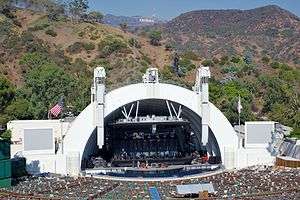 Hollywood Bowl in 2005 (with Hollywood Sign in background) | |
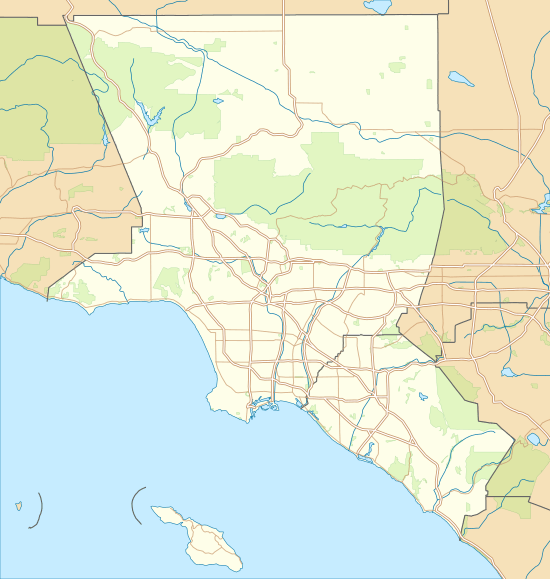 Hollywood Bowl Location within the Los Angeles metropolitan area  Hollywood Bowl Hollywood Bowl (California)  Hollywood Bowl Hollywood Bowl (the United States) | |
| Location | 2301 North Highland Avenue Los Angeles, California |
|---|---|
| Coordinates | 34°06′46″N 118°20′20″W |
| Public transit | |
| Owner | County of Los Angeles |
| Operator | Los Angeles Philharmonic Association |
| Type | Outdoor Amphitheater |
| Seating type | reserved seating |
| Capacity | 17,500 |
| Construction | |
| Opened | July 11, 1922 |
| Renovated | 2003–2004 |
| Website | |
| Official website | |
The Hollywood Bowl is known for its band shell, a distinctive set of concentric arches that graced the site from 1929 through 2003, before being replaced with a larger one beginning in the 2004 season. The shell is set against the backdrop of the Hollywood Hills and the famous Hollywood Sign to the northeast.
The "bowl" refers to the shape of the concave hillside the amphitheater is carved into. The Bowl is owned by the County of Los Angeles and is the home of the Hollywood Bowl Orchestra, the summer home of the Los Angeles Philharmonic, and the host venue to hundreds of musical events each year.[2]
It is located at 2301 North Highland Avenue, west of the (former) French Village,[3][4] north of Hollywood Boulevard and the Hollywood/Highland subway station, and south of Route 101.
History
Discovery and founding
The site of the Hollywood Bowl was chosen in 1919 by William Reed and his son H. Ellis Reed,[5] who were dispatched to find a suitable location for outdoor performances by the members of the newly formed Theatre Arts Alliance headed by Christine Wetherill Stevenson. The Reeds selected a natural amphitheater, a shaded canyon and popular picnic spot known as 'Daisy Dell' in Bolton Canyon which was chosen for its natural acoustics and its proximity to downtown Hollywood.[6] The Community Park and Art Association, then headed by F.W. Blanchard, was the first organization to begin the building the Bowl.
One of the earliest performances at the Bowl was Hollywood High School's Performance of Shakespeare's Twelfth Night. The Women's World Peace Concert was held on November 11, 1921. On November 11, 1921 the first Sunrise Service took place at the bowl, in one of its first major events.[7] With the building of the first actual stage, consisting of little more than wooden platforms in and canvas, The Bowl officially opened on July 11, 1922.[8][9]
Community Function
The Bowl began as a community space rather than a privately owned establishment. Proceeds from the early events at the Bowl went to financing the construction of new elements of the bowl such as a stage and seating in 1922 and 1923 respectively. In 1924, a backdrop to the stage was added.[10]
During the early years of the Bowl's existence, concert tickets were kept at the lowest available price of 25 cents using the slogan popular prices will prevail, coined by F.W. Blanchard. While serving as the venue for concerts by the Los Angeles Philharmonic, the Bowl also served as a community space, being used for Easter services, the Hollywood Community Chorus, as well as Young Artists Nights where younger musicians could perform well known classical music. Children were also invited to perform at community events with the Los Angeles Philharmonic and the Hollywood Community Chorus, beginning with Sibelius’ Finlandia in 1921.[11]
The Bowl was home to much more than western music, hosting a variety of Native American tribal events, as well as international music ensembles.[11]
In 1924, the land was deeded to the County of Los Angeles.[8]
Women in the Bowl
Many of the key influential figures in the founding of the Hollywood Bowl were women, most notably the pianist Artie Mason Carter, whose connections with the Los Angeles arts patrons were vital in the early days of the Bowls existence. Christine Wetherill Stevenson and Marie Rankin Clarke, who both donated $21,000 to purchase the land on which the bowl was built. E.J. Wakeman, Leiland Atherton Irish, Harriet Clay Penman, and composers Gertrude Ross and Carrie Jacobs Bond all contributed to the Bowl through fundraising drives.[12]
Band shells
Frank Lloyd Wright, Jr. (commonly known as Lloyd Wright) designed the second and third band shells.[13] The original 1926 shell, designed by the Allied Architects group, was considered unacceptable both visually and acoustically. Wright's 1927 shell had a pyramidal shape and a design reminiscent of southwest American Indian architecture. Its acoustics generally were regarded as the best of any shell in Bowl history. But its appearance was considered too avant-garde, or perhaps only ugly, and it was demolished at the end of the season. His 1928 wooden shell had the now-familiar concentric ring motif, covered a 120-degree arc, and was designed to be easily dismantled. Unfortunately it was neglected and ruined by water damage.
.jpg)
For the 1929 season, the Allied Architects built the shell that stood until 2003, using a transite skin over a metal frame. Its acoustics, though not nearly as good as those of the Lloyd Wright shells, were deemed satisfactory at first, and its clean lines and white, semicircular arches were copied for music shells elsewhere. As the acoustics deteriorated, various measures were used to mitigate the problems, starting in the 1970s with an inner shell made from large cardboard tubes (of the sort used as forms for round concrete pillars), which were replaced in the early 1980s by large fiberglass spheres (both designed by Frank Gehry[14]) that remained until 2003. These dampened out the unfavorable acoustics, but required massive use of electronic amplification to reach the full audience, particularly since the background noise level had risen sharply since the 1920s. The appearance underwent other, purely visual, changes as well, including the addition of a broad outer arch (forming a proscenium) where it had once had only a narrow rim, and a reflecting pool in front of the stage that lasted from 1953 till 1972.[15] Sculptor George Stanley, designer of the Oscar statuette, designed the Muse Fountain which has stood outside the Hollywood Bowl's main entrance since 1940.[16][17]
.jpg)
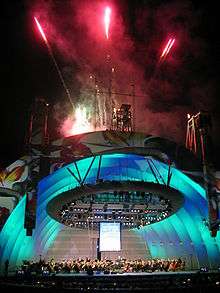
Shortly after the end of the 2003 summer season the 1929 shell was replaced with a new, somewhat larger, acoustically improved shell, which had its debut in the 2004 summer season. Preservationists fiercely opposed the demolition for many years, citing the shell's storied history. However, even when it was built, the 1929 shell was (at least acoustically) only the third-best shell in the Bowl's history, behind its two immediate predecessors. By the late 1970s, the Hollywood Bowl became an acoustic liability because of continued hardening of its transite skin. The new shell incorporates design elements of not only the 1929 shell, but of both the Lloyd Wright shells. During the 2004 summer season, the sound steadily improved, as engineers learned to work with its live acoustics.[18]
The current sound reinforcement system is a line-array configuration of multiple loudspeaker enclosures hung vertically in a curved manner, with the lower enclosures facing the front sections, and the upper enclosures angled towards the rear sections. It is manufactured by L'Acoustics, and includes state-of-the-art audio processing allowing each individual loudspeaker enclosure to be "tuned" and directed towards the near-precise location of the listener, regardless of where in the venue they are sitting. This results in the audience in the rear sections hearing the same audio, at the same level, as in the front sections. This electronic processing includes sound level, frequency equalization, occasional special effects, and time delay (sound passes through wire much faster than through air, therefore the sound coming from the speakers must be delayed, allowing the actual sound from the stage to "catch up" so both sources reach the listeners' ears simultaneously). The system is maintained by Rat Sound Systems, the same company that has provided audio for the Coachella Festival, since its inception.[19][20]
The 2004 shell incorporates the prominent front arch of the 1926 shell, the broad profile of the 1928 shell, and the unadorned white finish (and most of the general lines) of the 1929 shell. In addition, the ring-shaped structure hung within the shell, supporting lights and acoustic clouds, echoes a somewhat similar structure hung within the 1927 shell. During the 2004 season, because the back wall was not yet finished, a white curtain was hung at the back; beginning with the 2005 season, the curtain was removed to reveal a finished back wall. The architectural design for the shell was developed by the Los Angeles-based architectural practice Hodgetts and Fung, with the structural concept developed by the local office of Arup.
At the same time the new shell was being constructed the bowl received four new video screens and towers. During most concerts, three remotely operated cameras in the shell, and a fourth, manually operated camera among the box seats, provide the audience with close-up views of the musicians.
Hollywood Bowl Orchestra(s)
The Hollywood Bowl has had several house orchestras. A "Bowl Orchestra" performed in 1925, and a "Hollywood Bowl Orchestra" made a live recording in 1928. Later, the "Hollywood Bowl Symphony Orchestra" recorded made several classical recordings under music director Leopold Stokowski from 1945 to 1946, and released a number of recordings on the Capitol Records label in the 1950s and 1960s.
The Hollywood Bowl Orchestra was re-launched by the Los Angeles Philharmonic Association in 1991 under principal conductor John Mauceri, who finished his tenure in 2006.[21]
From among the Orchestra's more than 300 concerts, Kathleen Battle, Plácido Domingo, Jane Eaglen, Marilyn Horne, Alexander Frey, Jennifer Larmore, Sylvia McNair, Andrea Bocelli, Gil Shaham, Stephen Hough, Luciano Pavarotti and the San Francisco Ballet represent the illustrious talent from the worlds of opera, ballet and classical music that has graced the stage with the Orchestra. Trisha Yearwood, Garth Brooks (in his only performance with an orchestra) and the late John Denver brought to their performances the irrepressible optimism of Country-Western. Jason Alexander, Carol Burnett, Kristin Chenoweth, Kirk Douglas, Patti LuPone, Reba McEntire, Lynn Redgrave, Peabo Bryson, Harry Connick Jr., Alan Cumming, Davis Gaines, Savion Glover, Joel Grey, Garrison Keillor, Leonard Nimoy, Brian Stokes Mitchell and Patrick Stewart have brought their inimitable gifts to the Bowl stage. Hosting Big Bad Voodoo Daddy, Chicago, Cheap Trick, The Chieftains, Sergio Mendes, The Moody Blues, Pink Martini, Tito Puente and the Latin Jazz Ensemble, Royal Crown Revue, and Rufus Wainwright, the Orchestra has proven itself in the world of pop and rock. Rosemary Clooney, Natalie Cole, Ann Miller, Della Reese, Sir George Martin, and Peter, Paul & Mary are among artists with whom the Orchestra has been privileged to work. And, in the 1999 season, John Mauceri stepped aside to allow the mayor of Los Angeles, the Honorable Richard J. Riordan, to make his conducting debut at the Bowl with the Hollywood Bowl Orchestra.
Early Conductors
The first appointed conductor of the Bowl ensemble was Emil Oberhoffer, who served for one year. Oberhoffer was proceeded by Alfred Hertz for two years. In 1925 Fritz Reiner migrated to the orchestra from the Cincinnati Symphony. Reiner was supplanted by Sir Henry Wood several years later.
Early Ballet and Opera
Ballet dancer Maud Allen performed during the production of symphony Pathetique by Tschaikowsky under the direction of Alfred Hertz in 1926. Ernest Belcher arranged a ballet scene for Bowl Dedication Night, and dancers from the Belcher Ballet School performed the Beautiful Galatea, Enchanted Hour, and Venesive Festival. In 1932, the Belcher's ballet was performed in Greek Costumes as a dedication to the Olympic-Games Athletes. Alexis and Theodore Kosloff performed the ballet Scheherazade with dancers from Hollywood and the Klosloff Dancing School between 1930s. In 1932, Theodore Klosloff performed the Flower.Also in 1932, the ballet Chopiniana was performed. Ballet Dancers Ruth St. Denis and Ted Shawn performed solo dances under direction of Hertz in 1927. Ruth St. Denis and Ted Shawn raised there arms to point at the California Stars during the Russian Ballet sur le point at the Hollywood Bowl. In 1928, Andreas Pavley, a tenor, and Serge Oukrainsky, a ballet dancer, performed at the Hollywood Bowl. Oukrainsky performed in the ballet La Fete a Robinson alone after Pavley's death. In 1929, Norma Gould brought her Los Angeles dancers to the bowl to perform during Schubert's Unfinished Symphony and Tschaikowsky's Nut-Cracker Suite. In August, 1930, Michio Ito brought five dancers to the Hollywood Bowl to perform in the Russian Ballet Prince Igor. In 1931, Adolph Bolm performed at the Bowl for Debussy's Les Nuages. He also performed The Spirt factory. This was later called the Mechanical Ballet composed by Alaxander Mosolov. Dancers Elise Reiman and Robert Bell also performed in the Mechanical Ballet.[7]
In 1931, Los Angeles Grand opera performed segments of Marouf. Early Hollywood Bowl appearances of opera include: Carmen, Aida, and Shanewis. In 1929, a concertized form of the opera Carmen was performed by Alice Genytle, Paul Althouse and Alexander Kisselburgh. The same cast later performed moments from the opera Tannhauser. In 1932, Samson and Delilah was performed by Paul Althouse, local singers, the Belcher Ballet and the Civic Chorus in concert style. In 1927, Elsa Alsen performed Santuzza in Cavalleria. In 1934, Nina Koshetz performed Carmen and Nelson Eddy sang Escamillio in the opera Carmen. Koshetz also sang the lead in Tschaikowsky's Eugene Oregon. In the 1930s, Verdi's Aida was performed by Dan Gridley, Clemence Gifford, Eleanor Woodforde and Richard Bonelli with the Los Angeles Philharmonic Orchestra. In 1935, Lohengrin was performed by Jeanette Vreeland performing Elsa and Dan Gridley performing Lonhengrin.[22]
Performances
The first season at the Hollywood Bowl began on July 11, 1922, with conductor Alfred Hertz and the Los Angeles Philharmonic.[2]
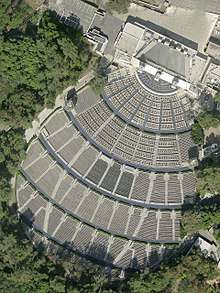
In 1945, Leopold Stokowski formed the Hollywood Bowl Symphony Orchestra, drawing its players from among members of the Los Angeles Philharmonic and various film studios orchestras. He made a number of 78 rpm recordings with them for RCA Victor during his two seasons there (1945–46) before returning to New York. The Hollywood Bowl Symphony's name was retained for a series of Capitol LPs made in the 1950s under such conductors as Felix Slatkin and Carmen Dragon.
In 1951, a financial crisis closed the Hollywood Bowl during its summer season. Dorothy Chandler chaired a committee that organized a series of fundraising concerts that was able to reopen it.[23]
The film-and-orchestra concert Bugs Bunny on Broadway, subsequently called "Bugs Bunny at the Symphony," has played the Hollywood Bowl a record 21 times—19 times with the Los Angeles Phiharmonic, and twice with the Hollywood Bowl Orchestra, all conducted by George Daugherty. In September 2003, "Bugs Bunny On Broadway" was the final Los Angeles Philharmonic concert to be performed in the 1929 shell before its demolition started the following day, making way for the new shell.
Public Figures – include President Franklin Delano Roosevelt, Mickey Rooney and Edward G. Robinson, Fonteyn and Nureyev, Nelson Eddy and Jeanette MacDonald, Simon and Garfunkel, and Abbott and Costello.
Dancers – Mikhail Baryshnikov has danced there, as did Fred Astaire.
Musicians – Al Jolson, Judy Garland, Billie Holiday, Louis Armstrong, Art Tatum, Buddy Rich, Harry "Sweets" Edison, Nat "King" Cole, Oscar Peterson, Ella Fitzgerald,[24] Carrie Underwood, The Doors, Van Halen, Rod Stewart, José José, Kylie Minogue, Elton John, Alicia Keys, Tom Petty and the Heartbreakers, Heart.[25]
1920s
1930s
- August 7, 1936: The Hollywood Bowl's set an attendance record of 26,410 at a performance by French opera star Lily Pons

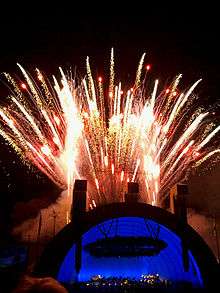
1940s
1950s
- September 1950: California's official state centennial show, The California Story, ran for five performances. The production, directed by Vladimir Rosing, was immense. A chorus of 200 and hundreds of actors were employed. The shell of the bowl was removed, the stage was enlarged, and the action was expanded to include the surrounding hillsides. Lionel Barrymore provided the show's dramatic narration.[30]
- August 15, 1956: A Jazz at the Philharmonic program featuring Louis Armstrong and His All Stars, Ella Fitzgerald, Art Tatum, and Oscar Peterson became the best-attended event of the venue's history.[31]
- American Baritone Mack Harrell performed in the US première of "David" in 1956.[32]
- Mary Costa substituted for Elisabeth Schwarzkopf at a 1958 gala concert.[33]
1960s
- The Beatles performed in 1964 and 1965,[34] which resulted in the live album The Beatles at the Hollywood Bowl that was released in 1977. This recording was re-released in 2016 with the screams of the fans significantly reduced and sound improved with new technology by Giles Martin.[35]
- July 22, 1966: The Rolling Stones
- July 5, 1968: L.A. rock band The Doors performed at the Hollywood Bowl. Recordings from this show were released in 1987 as the live album Live at the Hollywood Bowl. The Bowl was also home to the final performance of The Doors on September 10, 1972.
- August 16, 1968: Eric Burdon & The Animals performed at the Hollywood Bowl. A live tape of rather poor quality of their performance exists.
- September 14, 1968: The Jimi Hendrix Experience appeared at the Hollywood Bowl. This concert was recorded and eventually released as part of the 50th anniversary box set of Electric Ladyland.
1970s
- 1972: Pink Floyd played "Set the Controls for the Heart of the Sun" with a flammable gong. At the finale there was a fireworks session.
- June 17, 1972: Ron "Pigpen" McKernan played his last show with the Grateful Dead.
- José Carreras sang the duke of Mantua in "Rigoletto" and Rodolfo in "La Bohème" with the San Francisco Opera at the Hollywood Bowl in 1973.[36]
- July 23, 1972 Alice Cooper (w/ Captain Beyond, Jo Jo Gunne, Wolfman Jack)
- July 29, 1973: The World of Sid & Marty Krofft, a one performance only live show was filmed here and aired as a television special The World of Sid & Marty Krofft at the Hollywood Bowl. The show featured performances by Johnny Whitaker, Jack Wild with H.R. Pufnstuf characters and The Brady Bunch Kids.
- September 7, 1973: Elton John played a concert here that was filmed for inclusion in the Bryan Forbes documentary film Elton John and Bernie Taupin Say Goodbye Norma Jean and Other Things.
- 1979: the inaugural Playboy Jazz Festival was held. It has taken place at the Hollywood Bowl ever since.[37]
1980s
- 1980: The Monty Python comedy troupe performs. A filmed performance is released as Monty Python Live at the Hollywood Bowl. (see below)
1990s
- July 2–4, 1991: The newly formed Hollywood Bowl Orchestra made their debut performance with Independence Day concerts on conducted by John Mauceri. The program included works by Aaron Copland, Leonard Bernstein, John Williams, George Gershwin & Jerome Kern, among others.
- October 11, 1997: Prince performed at The Hollywood Bowl.
- July 12, 1998: American pop group Hanson performed at The Hollywood Bowl.
2000s
- July 1, 2002: The Who performed their first concert after the death of John Entwistle.[38]
- April 29–30, 2005: Cher performed the final two concerts of her Living Proof: The Farewell Tour.[39]
- October 1, 2005: Nine Inch Nails Live with Teeth
- November 6 and 8, 2005: The Rolling Stones A Bigger Bang Tour concert.
- November 4 & 5, 2006: The Who Endless Wire Tour
- October 12 and 13, 2007: Genesis performed the last two concerts of their Turn It On Again: The Tour. These are the last concerts the band has ever performed. At the last of the two concerts, lead singer Phil Collins said, "there was nothing else planned for Genesis after this show." Phil Collins would retire from the music industry in 2011.[40]
- August 16–17, 2009: Depeche Mode performed at the amphitheatre as part of their Tour of the Universe, in front of a crowd of 34,919 people.
- October 4, 2009: Kylie Minogue performed at the amphitheatre during her For You, for Me tour.
2010s
- James Taylor has performed several times at the Hollywood Bowl. he performed with Carole King in 2010 during the Troubadour World Reunion Tour.
- August 2011: Phish made their Hollywood Bowl debut.[41]
- June 2, 2012: The Beach Boys played a concert here as part of their The 50th Reunion Tour.
- November 8, 2013: Avicii performed at the Hollywood Bowl, becoming the first EDM artist to headline the venue.
- May 30–31, 2015: Lady Gaga and Tony Bennett performed together as part of their Cheek to Cheek Tour.
- September 20, 2015: Empire of the Sun performed for the first time during their Ice on the Dune tour.
- September 25–26, 2015: Kanye West performed his 4th solo album 808s & Heartbreak in full for the first time ever.
- July 1, 2016: Garrison Keillor recorded his final episode of A Prairie Home Companion from the Hollywood Bowl which was later released as a Live CD.[42]
- July 22–23, 2016: "Weird Al" Yankovic performed during his Mandatory World Tour
- September 18, 2016: Kraftwerk makes their debut performance during their 3D US Tour.[43]
- October 14,15 2016: Kygo performed during his Cloud Nine Tour. The concerts were filmed in the documentary: "Kygo: Live at the Hollywood Bowl" available at iTunes.
- June 2-3-4, 2017: Pentatonix makes their debut performance during their Tour.
- June 17, 2017: The Moody Blues performed during the Days of Future Passed 50th anniversary tour.
- June 23, 2017: Jason Mraz's 40th Birthday party and concert.[44]
- June 26, 27, 2017: Queen + Adam Lambert performed during their Queen + Adam Lambert Tour 2017-2018
- July 9, 2017: Blondie and Garbage performed to a sold-out crowd during their first-ever and only joint tour with Sky Ferreira serving as the opening act on the Rage and Rapture Tour.
- September 8, 9, 10: The Muppets performed
- September 17, 2017: Mon Laferte performed during her Amarrame Tour alongside La Santa Cecilia and Cafe Tacvba[45]
- September 21, 22, 25: Tom Petty and the Heartbreakers completed their 40th Anniversary World Tour; final shows of Petty's career before his death on October 2.[46]
- October 5, 2017: Lauryn Hill and Nas performed during their Powernomics Tour[47]
- October 27, 2017: Linkin Park held a tribute concert for Chester Bennington[48]
- May 12, 2018: The Iranian music legend Googoosh along with iconic singers and songwriters Hassan Shamaizadeh and Martik Kanian performed their Memory Makers Tour. Googoosh became the first Iranian artist to headline at the Hollywood Bowl.[49]
2020s
- May 13, 2020: Due to the COVID-19 pandemic, the entire season of film screenings and concerts was cancelled for the first time.[50][51]
Hollywood Bowl Museum
The Hollywood Bowl Museum is located at the bottom of Peppertree Lane. It was formally known as the Tea Room which opened in 1984.[52] In 1996, it was rebuilt as the Edmund D. Edelman Hollywood Bowl Museum.[53] It features many historical exhibits including: Summer Nights: Jazz at the Bowl, Hollywood Bowl: Music For Everyone, Postcards from the Bowl, Beatles at the Bowl, Concert Programs and Live from the Bowl. These exhibits feature vintage photographs, vintage sound equipment, newspaper clippings, postcards, live video recordings, and live audio recordings.[53] The Hollywood Bowl Museum also features memorabilia and artifacts about the history of the Hollywood Bowl and performances.The Hollywood Bowl Museum features memorabilia and artifacts about the history of the Hollywood Bowl and performances. The museum includes the Hollywood Bowl Hall of Fame, whose honorees include John Williams, Reba McEntire, Garth Brooks, Stevie Wonder, Brian Wilson, Henry Mancini, Sarah Chang, Bernadette Peters, George Harrison, Frank Sinatra and more.[54] The Hollywood Bowl Museum offers free admission, free self guided tour options, free guided tour options and educational programs.The educational program, Music Mobile, is a volunteer program and offers musical instrument lessons to students twice a year.[52] If the Hollywood Bowl Museum is closed visitors can walk through "The Bowl Walk" which features historical photographs of the Hollywood Bowl.[52]
In popular culture
Films
- Moonlight Murder (1936), in which police detective Chester Morris solves a murder during a performance of Il Trovatore at the Bowl.
- A Star Is Born (1937)
- Hollywood Hotel (1937)[55] in which Rosemary Lane sings to Dick Powell.
- Double Indemnity (1944)
- Anchors Aweigh (1945) with Gene Kelly, Frank Sinatra and Jose Iturbi.
- Nobody Lives Forever (1946) starring John Garfield
- Long-Haired Hare (1948); Bugs Bunny short film
- It's a Great Feeling (1949)
- Tom and Jerry in the Hollywood Bowl (1950); Tom and Jerry short film
- Champagne for Caesar (1950); Ronald Colman, Celeste Holm, Vincent Price.
- Dixieland Droopy (1954) MGM short film with Droopy
- Hollywood or Bust (1956)
- Baton Bunny (1959); Bugs Bunny short film
- Two on a Guillotine (1965); with Cesar Romero, Connie Stevens and Dean Jones – directed by William Conrad.
- A Perfect Couple (1979)
- Xanadu (1980)
- Monty Python Live at the Hollywood Bowl (1982)
- Some Kind of Wonderful (1987)
- Beaches (1988), where Bette Midler's character CC Bloom is rehearsing for her concert at the Bowl, and where she performs at the end of the film.
- Hanna-Barbera's 50th: A Yabba Dabba Doo Celebration (1989)
- Jimmy Hollywood (1994)
- Pink, Plunk, Plink (1966) Pink Panther prefers the orchestra performing at the Hollywood Bowl to play The Pink Panther theme than their scheduled program to an audience consisting of the composer Henry Mancini.
- Escape from L.A. (1996)
- Lost & Found (1999)
- Shrek 2 (2004), in the animated Far Far Away Idol DVD extra
- Yes Man (2008)
- Zombieland (2009) Bill Murray mentions that he saw Eddie Van Halen at the Hollywood Bowl.
Television
- The Beverly Hillbillies (1963) in season 1 episode 23 "Jed Buys the Freeway," a conman attempts to sell the Clampetts the Hollywood Bowl, Griffith Park Zoo, and the freeway connecting the two.[56]
- Gomer Pyle USMC (1968) in episode 6 "All You Need Is One Good Break" in season 5. Gomer, Sgt. Carter, and their new actress friend take various photos there.
- Sleeper Cell (2006) in episode 7 "Fitna" in season 2. The Hollywood Bowl is the target of a dirty nuclear bomb.
- Californication (2008) in episode 9 "La Ronde" in season 2. Ashby steals Karen away on a date and surprises her with a private Lili Haydn concert at the Hollywood Bowl.
- CSI: Miami (2010) in episode 16 "L.A." in season 8. Horatio Caine meets Captain Sutter at the Hollywood Bowl at the end of the episode.
- Columbo (1972) Étude in Black starring Peter Falk and John Cassavetes. Most of the episode takes place at the Hollywood Bowl.
- The New Adventures Of Old Christine (2008) Season 3 Episode #6 "The New Adventures Of Old Christine" Originally aired May 3, 2008. Christine tags along with her ex and her brother to the Hollywood Bowl.
- Freakazoid (1997) The final scene of the last episode of the 1997 animated superhero comedy Freakazoid features the cast singing We'll Meet Again at the Hollywood Bowl
- 90210
- Burke's Law (1964) in the episode "Who Killed Vaudeville?", the final scene is set on the Bowl's stage.
- Lucifer (2018) In the episode "Let Pinhead Sing" a singer was the intended target during a performance but her double was killed instead.
- This Is Us (2020) In the episode “Light and Shadows” Kevin takes a woman on a first date.
Hollywood Bowl Green Initiatives
"The Hollywood Bowl is the first amphitheater in California to be certified as an Audubon Society Cooperative Sanctuary."[57] Los Angeles Philharmonic Association and Los Angeles County are partners with the Hollywood Bowl and encourage recycling. The Hollywood Bowl has many recycling bins located throughout the venue. The Hollywood Bowl has also partnered with Los Angeles County Metropolitan Transportation authority since 1953 and provides the public with a green alternative to driving. Know Before You Go is provided as a detailed guide offering public transport information and free bike parking options. The Hollywood Bowl has waterless urinals and flush reducing toilets to preserve water as well as a satellite-based irrigation system to control water use. This irrigation system also provides water based on the needs of animal life. The Hollywood Bowl has stainless steel grates and water filters to keep its irrigation system clean.[57]
Animal Life
- Coyote (Canis latrans)
- Raccoon (Procyon lotor)
- Striped Skunk (Mephitis mephitis)
- California ground squirrel (Spermophilus beecheyi beecheyi)
- Mule deer (Odocoileus haemionus)
- Virginia opossum (Didelphis virginianus)
- Eastern fox squirrel (Sciurus niger)
- Brush rabbit (Sylvilagus bachmani)
- Red-tailed hawk (Buteo jamaicensis)
- California quail (Callipepla californica)
- Anna's hummingbird (Calypte anna)
- Western scrub-jay (Aphelocoma californica)
- Common Raven (Corvus corax)
- Northern Mockingbird (Mimus polyglottos)
- Black Phoebe (Sayornis nigricans)
- Cooper's hawk (Accipiter cooperii)
- Great horned owl (Bubo virginianus)
- Band-tailed pigeon (Patagioenas fasciatus)
- Mourning dove (Zenaida macroura)
- American crow (Corvus brachyrhynchos)
- Gopher snake (Pituophis melanoleucus)
- Western Fence Lizard (Sceloporus occidentalis)
- Southern alligator lizard (Elgaria multicarinata)[57]
Plant-life
- Coast Live Oak (Quercus agrifolia)
- Black Sage (Salvia mellifera)
- Coffeeberry (Rhamnus californica)
- Monkey Flower (Mimulus purpureus)
- Poison Oak (Toxicodendron diversilobum)
- Toyon (Heteromeles arbutifolia)
- Barberry (Berberis fendleri)
- Fuchsia-flowered Gooseberry (Ribes speciosum)
- Lemonade Berry (Rhus integrifolia)
- Meadow-rue (Thalictrum flavum)
- Sugar Bush (Rhus ovata)
- Yucca (Hesperoyucca whipplei)
- California Sycamore (Platanus racemosa)
- California Lilac (Ceanothus oliganthus)
- Elderberry (Sambucus cerulea)
- Scrub Oak (Quercus berberidifolia)
- Phacelia (Phacelia grandiflora)
- White Nightshade (Solanum americanum)[58]
See also
- Live at the Hollywood Bowl (disambiguation)
- List of contemporary amphitheatres
- List of Los Angeles Historic-Cultural Monuments in Hollywood
- National Bowl
- Waikiki Shell
- Sidney Myer Music Bowl
- Tom and Jerry in the Hollywood Bowl
- Long-Haired Hare
- CNE Bandshell
- Korean Music Festival
References
- Staff (13 December 2018). "10 Best Live Music Venues in America. From big rooms to intimate spaces, here's a selection of some of the country's best live music spots". Rolling Stone Magazine. Retrieved 23 December 2018.
- "Hollywood Bowl History". Hollywood Bowl. Retrieved 2019-03-06.
- "The Lost French Village of Hollywood". 2010-12-09.
- https://martinturnbull.com/2014/11/22/the-french-village-corner-of-highland-ave-cahuenga-blvd/
- "From Daisy Dell to the Hollywood Bowl, a Little Musical History for Summer". Kcet.org. 2011-06-23. Retrieved 18 January 2015.
- http://www.kcet.org/updaily/socal_focus/history/la-as-subject/from-daisy-dell-to-the-hollywood-bowl-34638.html
- Jones, Isabel Morse (1936). Hollywood Bowl. New York, NY Los Angeles, CA: G.S Schirmer, Inc. pp. 141–148.
- "Hollywood Bowl History". Hollywood Bowl. Retrieved 2019-03-05.
- "PCAD - Hollywood Bowl, Hollywood, Los Angeles, CA". pcad.lib.washington.edu. Retrieved 2020-06-10.
- "Hollywood Bowl History". Hollywood Bowl. Retrieved 2019-03-01.
- H., Marcus, Kenneth (2004). Musical metropolis : Los Angeles and the creation of a music culture, 1880-1940. New York: Palgrave Macmillan. ISBN 1403964181. OCLC 54543818.
- H., Marcus, Kenneth (2004). Musical metropolis : Los Angeles and the creation of a music culture, 1880-1940. New York: Palgrave Macmillan. ISBN 1403964181. OCLC 54543818.
- Miranda, Carolina A. (January 9, 2019). "Lloyd Wright's Sowden House, possible Black Dahlia murder site, becomes a performance stage". Los Angeles Times. Retrieved 10 January 2019.
It’s a feature that makes sense given that Wright also designed one of the original band shells for the Hollywood Bowl.
- Isenberg, Barbara. Conversations with Frank Gehry. Knopf, 2009, p. 107.
- "Hollywood Bowl". Hollywoodbowl.com. Archived from the original on 22 July 2010. Retrieved 18 January 2015.
- "Muse Fountain". Hollywoodbowl.com. Archived from the original on 22 July 2010. Retrieved 18 January 2015.
- "Hollywood Bowl Sculpture - Los Angeles CA - Living New Deal". Living New Deal. Retrieved 15 May 2018.
- "Hollywood Bowl Acoustics Project". Acentech.com. Retrieved 18 January 2015.
- Don2yhatawe. "Hollywood Bowl Enhances its L-Acoustics System with New Amplified Controllers". L-Acoustics. Retrieved 2019-03-06.
- Hurwitz, By Matt (October 2014). "The Hollywood Bowl: A Unique Blend of Natural Acoustics and Amplified Sound". Mixonline. Retrieved 2019-03-06.
- "Meet the Orchestra". Hollywood Bowl. Retrieved 2019-03-01.
- Jones, Isabel Morse (1936). Hollywood Bowl. New York, NY Los Angeles, CA: G.S Schirmer, Inc. pp. 158–161.
- "About the Hollywood Bowl". Hollywood Bowl.
- Scott Yanow. "Jazz at the Hollywood Bowl – Various Artists – Songs, Reviews, Credits, Awards – AllMusic". AllMusic. Retrieved 18 January 2015.
- Wood, Mikael (October 16, 2015). "Q&A: Who's responsible for Jay Z, Jimmy Buffett and Kanye at the Bowl? Talk to these guys". Los Angeles Times.
- Palmer, A. Dean; Lush, Paige Clark (2013). "Blackstone, Tsianina Redfeather | Grove Music". www.oxfordmusiconline.com. doi:10.1093/gmo/9781561592630.article.A2248380. Retrieved 2019-02-28.
- Koegel, John (2015). "Díaz [Diaz], Rafaelo | Grove Music". www.oxfordmusiconline.com. doi:10.1093/gmo/9781561592630.article.A2284191. Retrieved 2019-02-28.
- "London [Burnstein, Burnson], George | Grove Music". www.oxfordmusiconline.com. doi:10.1093/gmo/9781561592630.article.16922. Retrieved 2019-02-28.
- Ellison, Cori (2002). "Quartararo, Florence | Grove Music". www.oxfordmusiconline.com. doi:10.1093/gmo/9781561592630.article.O005501. Retrieved 2019-02-28.
- Ainsworth, Ed., "Narration by Barrymore Highlight of Pageant", Los Angeles Times, Sept 13, 1950.
- Maxwell, Tom (November 2016). "The Story of 'Ella and Louis,' 60 Years Later". Longreads. Longreads.com. Retrieved 21 November 2016.
- Dyer, Richard; Forbes, Elizabeth (2001). "Harrell, Mack | Grove Music". www.oxfordmusiconline.com. doi:10.1093/gmo/9781561592630.article.42150. Retrieved 2019-02-28.
- "Seigenthaler, Costa to Receive Honorary Degrees in May". University of Tennessee Knoxville News. March 1, 2013. Retrieved 2019-03-15.
- "Rock & Roll". Hollywood Bowl website. Hollywood Bowl. Archived from the original on 24 October 2010. Retrieved 11 October 2010.
- "All Songs +1: The Beatles Are Live and Sounding Better Than Ever".
- "Carreras, José | Grove Music". www.oxfordmusiconline.com. doi:10.1093/gmo/9781561592630.article.05014. Retrieved 2019-02-28.
- "Playboy Jazz Festival". Playboyjazzfestival.com. Archived from the original on 2011-07-15. Retrieved 18 January 2015.
- "The Who: Los Angeles, CA, Mon, 01 July 2002". Thewholive.net. Retrieved 18 January 2015.
- "Cher's last stop: Hollywood Bowl". Los Angeles Times. February 1, 2005. Retrieved 3 December 2010.
- Wardrop, Murray (March 3, 2011). "Phil Collins calls time on music career". The Telegraph. Retrieved 2 October 2013.
- Anderson, Eric (August 11, 2011). "On the Download: Phish at the Hollywood Bowl". Access Hollywood. Retrieved 2 October 2013.
- Vankin, Deborah (1 July 2016). "Garrison Keillor reflects at the Hollywood Bowl, rehearsing for final show: 'I just want it to be good' – LA Times". Los Angeles Times. Retrieved 3 July 2016.
- Stearns, Colby (19 September 2016). "Here come the robots: It's still fun to compute with Kraftwerk in its Hollywood Bowl debut – LA Times". Los Angeles Times. Retrieved 19 September 2016.
- "Jason Mraz's 40th Birthday Hollywood Bowl Celebration: The Best Moments". 2017-06-24.
- "Archived copy". Archived from the original on 2018-02-01. Retrieved 2018-11-28.CS1 maint: archived copy as title (link)
- "Watch Tom Petty Play 'American Girl' at His Final Concert". Rolling Stone. 2017-10-03. Retrieved 2017-10-07.
- Leight, Elias (May 30, 2017). "Lauryn Hill, Nas Announce North American Tour". Rolling Stone. Retrieved 17 August 2017.
- "Linkin Park & Friends - Celebrate Life in Honor of Chester Bennington". LinkinPark.com. September 18, 2017. Archived from the original on September 19, 2017. Retrieved September 18, 2017.
- "Googoosh at the Hollywood Bowl". farhang.org. May 12, 2018. Retrieved May 13, 2018.
- Gelt, Jessica (2020-05-13). "Hollywood Bowl season canceled for the first time in 98 years. So long, L.A. summer". Los Angeles Times. Retrieved 2020-05-14.
- Gelt, Jessica (2020-05-13). "The Hollywood Bowl domino effect: Layoffs and furloughs follow season cancellation". Los Angeles Times. Retrieved 2020-05-14.
- "Hollywood Bowl Museum". LA Phil. Retrieved 2019-02-28.
- "Museum". Hollywood Bowl. Retrieved 2019-02-28.
- "Hollywood Bowl Museum". Hollywood Bowl. Retrieved 24 November 2014.
- "Hollywood Hotel (1937)". IMDb. 15 January 1938. Retrieved 18 January 2015.
- "Jed Buys The Freeway". Internet Archive. Retrieved 18 January 2015.
- "Hollywood Bowl Green Initiatives". Hollywood Bowl. Retrieved 2019-02-28.
- "Hollywood Bowl Green Initiatives". Hollywood Bowl. Retrieved 2019-02-27.
Further reading
- John Rubinstein (2002). The Hollywood Bowl – Music Under the Stars (Documentary). Video Artists International, Inc.
External links
| Wikimedia Commons has media related to Hollywood Bowl. |
- Official website
- The Story of a Hollywood Bowl Soundman
- "A Day in the Life" brief podcast about music at the venue.
